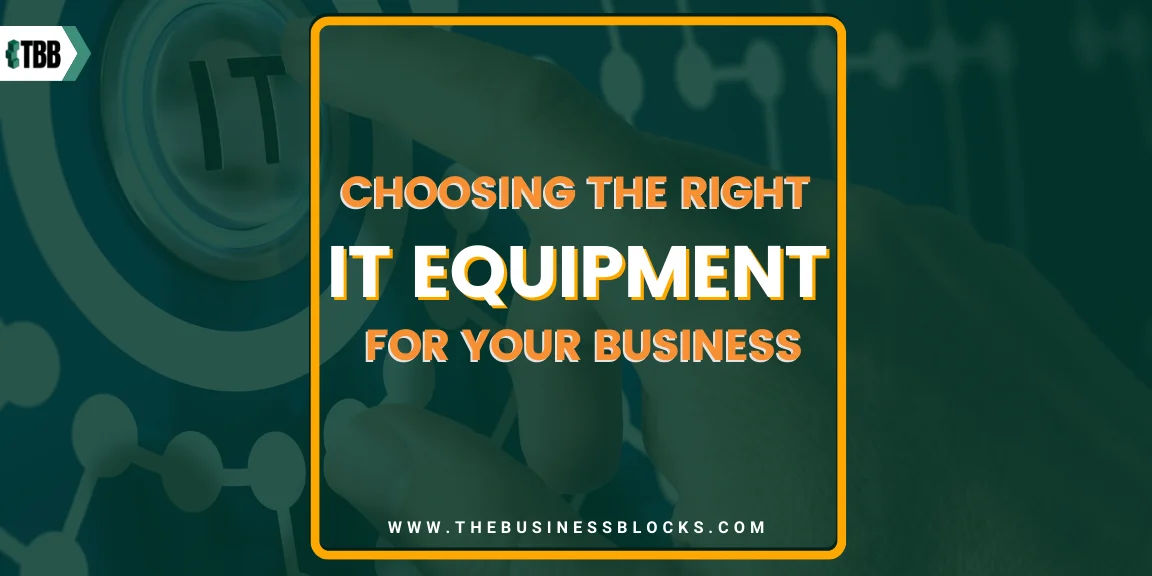In today’s fast-paced business environment, having the right IT equipment can make all the difference in staying competitive and efficient. With so many different options available, choosing the right IT equipment for your business can be a daunting task. In this article, we will discuss some key factors to consider when selecting IT equipment that meets your business needs. We will also take a look at some of the most common types of IT equipment in use in different business operations. So, read on to learn more about how to choose the right IT equipment for your business.
How do you know which IT Equipment is right for your business?
As technology continues to evolve, businesses are becoming increasingly reliant on IT equipment to streamline operations and drive growth. The right IT equipment can improve efficiency, reduce costs, and enhance overall productivity. But with a plethora of options available in the market, selecting the right equipment can be overwhelming. That’s why it’s important to understand your business needs before making any purchasing decisions.
Imagine having a team of employees who are equipped with the latest and most efficient IT equipment. They are able to complete tasks quickly, communicate seamlessly, and work more efficiently. This not only leads to increased productivity but also boosts employee morale and satisfaction.
Keep reading and we’ll explore some key factors to consider when selecting IT equipment for your business.
Exploring IT Equipment and Their Uses
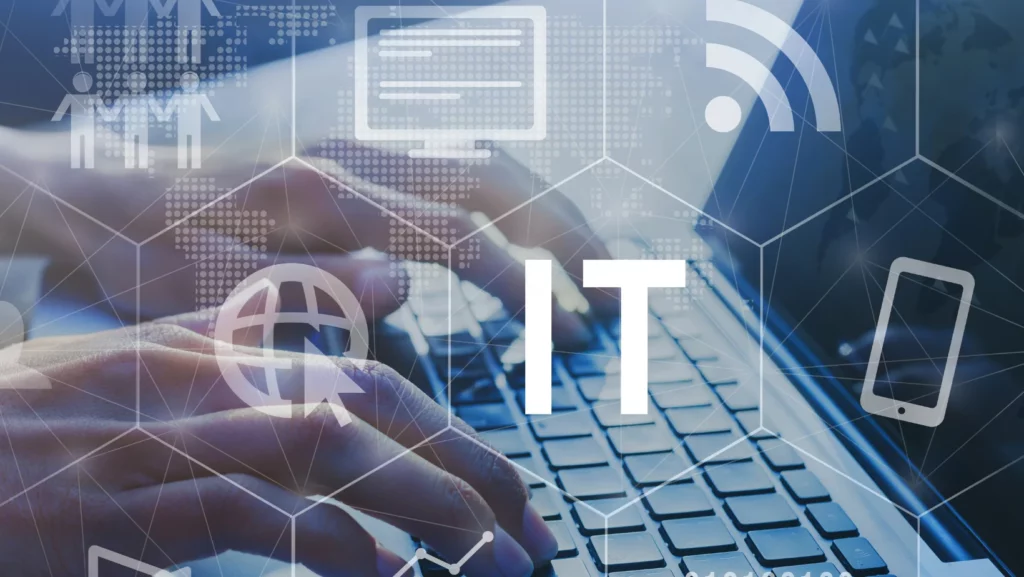
IT equipment is an essential part of any modern business. These equipment can range from hardware such as computers and servers, to software such as operating systems and productivity tools.
Here are some of the most common types of IT equipment and their uses including but not limited to:
Computers
Computers are the most basic and essential piece of equipment in any modern workplace. They come in various forms, including desktops, laptops, and tablets. Depending on your specific business needs, you may require one or multiple types of computers for your team.
Servers
Servers are powerful computers that store and manage data for a network of computers. They are essential for businesses that require large storage capacity, such as those with extensive databases or media files. Servers can also help improve network efficiency by centralizing resources and providing access to multiple users at once.
Networking Equipment
This category includes routers, switches, and hubs, which are all critical components in building a network infrastructure. This equipment allows for the sharing of resources such as internet access, printers, and files among multiple devices. Investing in the right networking equipment can improve network performance and security, leading to a more efficient and secure work environment.
Printers and Scanners
Printers and scanners are crucial in creating physical copies of documents and images. These devices come in various types, including laser printers for high-volume printing and all-in-one printers that can also scan and copy documents. Depending on your business needs, you may require a specific type or multiple types of printers and scanners.
Mobile telephones or Desk phones
For businesses that require constant communication, having reliable phone systems is crucial. Desk phones are traditional office phones that allow for voice calls and sometimes video conferencing. On the other hand, mobile telephones provide more flexibility by allowing employees to make and receive calls while on the go.
These are just a few of the many types of IT equipment available for businesses. It’s important to research and consider your specific business needs before making any purchases, as investing in the right equipment can greatly benefit your company in the long run.
Choose the Right IT Equipment for your Business with these 5 Steps
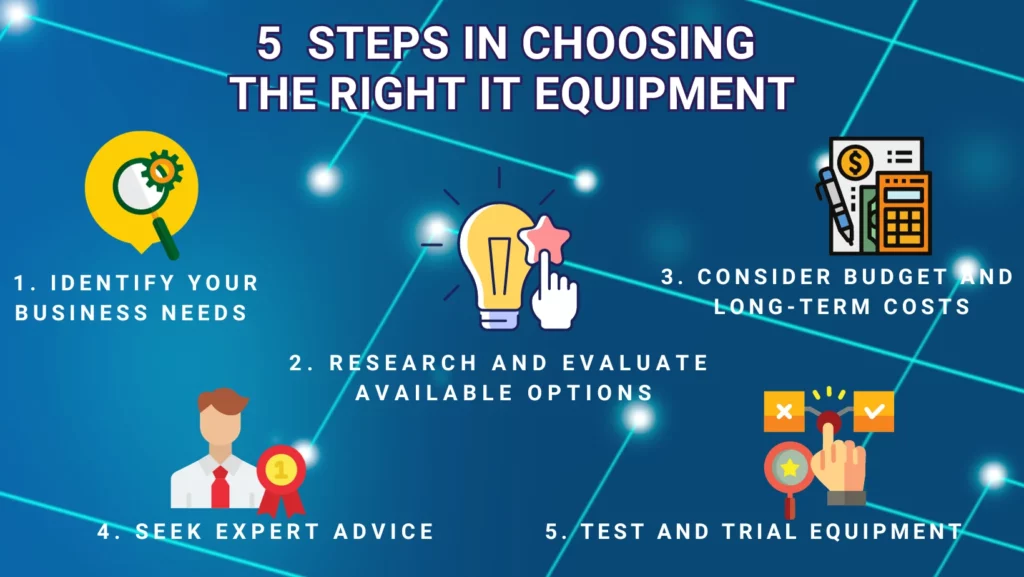
Using the 5 Steps listed below, you can determine the best IT equipment for your business.
1. Identify your business needs and objectives
The first and most important step in choosing the right IT equipment for your business is understanding your specific business needs. Every business has unique requirements, and it’s crucial to identify them before making any IT equipment purchases. For example, if your business requires employees to work remotely, investing in laptops and mobile phones may be a priority.
2. Research and evaluate available options
After you identify your business needs, the next step is to research and evaluate different IT equipment options available in the market. Consider factors such as quality, compatibility with existing systems, technical support, and cost when comparing different options. This will help you make an informed decision based on your business needs and budget.
3. Consider budget and long-term costs
While it may be tempting to choose the cheapest option, it’s important to consider the long-term costs of your IT equipment. For example, a lower-priced computer may end up costing more in repairs and replacements down the line. Consider investing in quality equipment that may have a higher upfront cost but can save you money in the long run.
4. Seek expert advice if needed
If you’re unfamiliar with IT equipment, it’s always a good idea to seek expert advice. Consult with an IT professional or technology consultant who can provide insights and recommendations based on your business needs. They can also help ensure that the equipment you choose is compatible with your existing systems and infrastructure.
5. Test and trial equipment before making a final decision
Before making a final decision, it’s important to test and trial the chosen equipment. This will give you an opportunity to see how they perform in a real-life setting and make any necessary adjustments before fully implementing them into your business operations. You may ask your employees to provide feedback during the testing phase to ensure their needs and preferences are also considered.
By following these steps, you can ensure that the IT equipment you choose aligns with your business needs, fits within your budget, and helps drive growth and efficiency in your company. Remember to regularly review and update your IT equipment as your business evolves to stay current with technological advancements and maintain a competitive edge. So, carefully consider your options and make the best decisions for your business to reap the benefits of efficient IT equipment.
The Importance of Choosing the Right IT Equipment
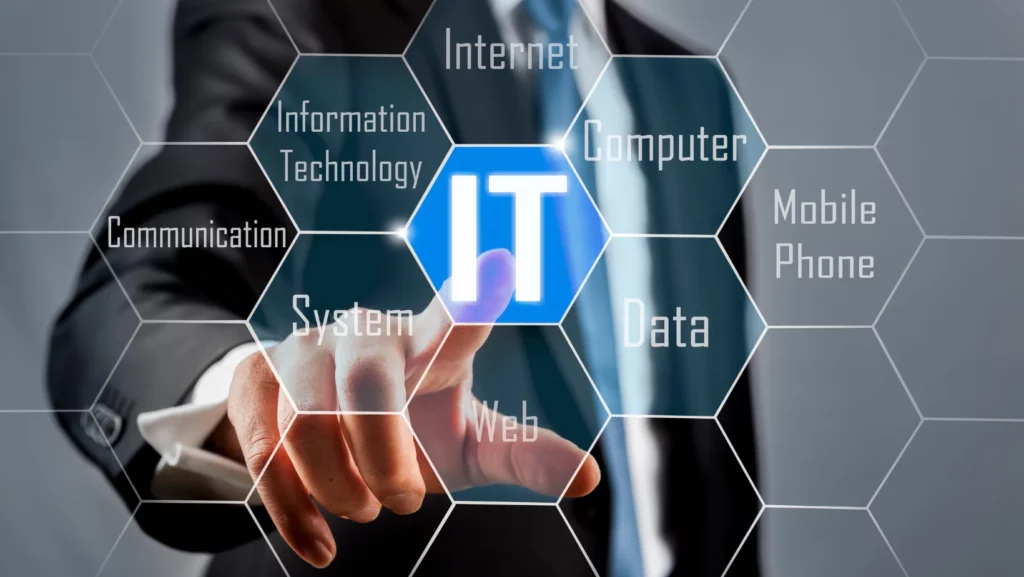
Choosing the right IT equipment is crucial for businesses of all sizes. It can greatly impact productivity, efficiency, and the overall success of a company. The right equipment can help streamline processes, improve communication and collaboration among team members, and increase data security.
In contrast, the wrong equipment can lead to slow performance, system crashes, and potential security breaches. Therefore, making informed decisions when it comes to IT equipment is essential for any business looking to stay competitive in today’s fast-paced digital landscape. So, invest time and resources in choosing the right IT equipment for your business to set it up for long-term success.
Moreover, here are the top three benefits of choosing the right IT equipment for your business:
1. Increased productivity and efficiency
Having the right IT equipment can greatly enhance productivity and efficiency in the workplace. With reliable computers, fast internet connection, and compatible software, employees can perform tasks more quickly and accurately, allowing them to complete their workloads on time. This not only improves employee satisfaction but also helps businesses meet deadlines and deliver high-quality products or services to customers.
2. Improved communication and collaboration
Effective communication is crucial for any business, and the right IT equipment can greatly facilitate this. With tools such as video conferencing software, instant messaging applications, and cloud-based file-sharing systems, employees can easily communicate and collaborate regardless of their location. This improves teamwork and helps businesses stay connected even when working remotely or across different time zones.
3. Enhanced data security
In today’s digital landscape, data security is a top concern for businesses of all sizes. Investing in the right IT equipment can greatly improve data security by providing reliable firewalls, antivirus software, and encryption tools to protect sensitive information from cyber threats. This not only protects your company’s reputation but also helps build trust with customers who entrust you with their personal information.
As you can see, choosing the right IT equipment for your business is crucial for its success. By following these steps and considering the additional benefits, you can make informed decisions when it comes to purchasing IT equipment that will best support your business needs and goals.
Factors to consider when choosing IT equipment
When evaluating different IT equipment options, it’s important to consider the following factors:
- Quality and reliability of the equipment: This means choosing reputable brands and suppliers that offer high-quality equipment with reliable warranties and technical support.
- Compatibility with existing systems: It’s important to consider how the new equipment will integrate with your current IT infrastructure to avoid potential compatibility issues.
- Cost, both upfront and long-term: As discussed earlier, it’s important to consider both the initial investment and the potential long-term costs of maintaining and upgrading the equipment.
- User-friendliness: Choose equipment that is easy to use and understand for your team members to avoid costly training or delays in productivity.
- Scalability to accommodate future growth or changes in technology: Investing in equipment that can adapt to your business’s evolving needs and the constantly changing technological landscape can save you money in the long run.
By carefully considering these factors, you can choose IT equipment that aligns with your business needs and budget while also providing a positive impact on your company’s operations.
Examples of IT Equipment According to Business Needs
Different types of businesses have varying IT equipment needs. Here are some examples of the most common types of equipment for different business purposes:
- Office Operations: For general office operations, you will need desktop computers or laptops, printers and scanners, routers and modems, telephone systems, and software such as Microsoft Office. Additional equipment such as servers may be needed for larger companies with extensive data storage needs.
- Retail and Point-of-Sale Systems: Retail businesses will require equipment such as cash registers, barcode scanners, point-of-sale software, and credit card terminals for payment processing.
- Digital Marketing and Communication: For businesses focused on digital marketing and communication, equipment such as high-speed internet connection, video conferencing systems, content creation tools, and social media management platforms are essential.
- Data-Centric Businesses: For companies that rely heavily on data, equipment such as servers, network storage devices, and backup solutions are vital to ensure safe and secure data management.
By understanding your business needs and considering the factors listed above, you can make informed decisions when it comes to choosing the right IT equipment for your company.
Tips for Maintaining IT Equipment
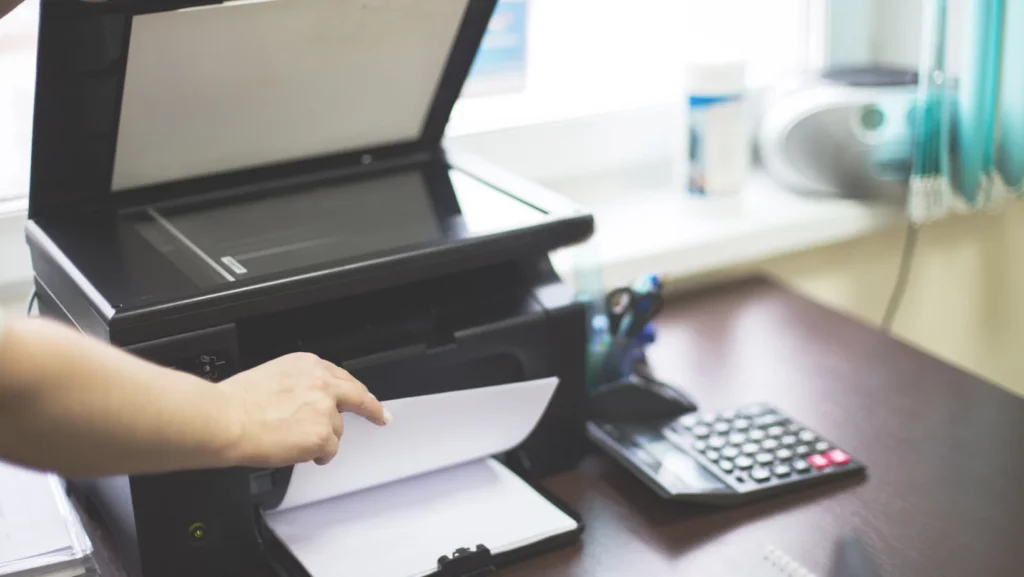
Once you have invested in the right IT equipment for your business, it’s important to properly maintain and care for it to ensure its longevity. Let us give you some tips to help you keep your equipment in top shape.
- Regularly clean and dust your equipment: Dust can build up in computers, printers, and other electronics, causing them to overheat and potentially malfunction. Use compressed air or a soft cloth to regularly clean the surfaces of your equipment.
- Protect from power surges: Power surges can damage IT equipment, so it’s important to use surge protectors or uninterruptible power supplies (UPS) to prevent this.
- Update software and perform regular maintenance checks: Make sure to install updates for your software and hardware as these often contain bug fixes and security patches. Additionally, schedule regular maintenance checks for your equipment to catch any potential issues early on.
- Train employees on proper usage and care: Your employees play a crucial role in maintaining IT equipment, so it’s important to train them on how to properly use and care for the equipment. This can help prevent accidental damage or misuse.
By taking these steps, you can ensure your IT equipment remains in top condition, providing reliable support for your business operations. Investing in the right IT equipment is a crucial decision for any business. By considering proper maintenance practices, businesses can reap the benefits of efficient operations, enhanced data security, and improved productivity.
Frequently Asked Questions About Choosing the Right IT Equipment for Your Business
Q: What is the difference between hardware and software?
A: Hardware refers to physical components such as computers, servers, routers, etc. Software, on the other hand, are digital program or application that runs on hardware and performs specific tasks. Both are essential for a functioning IT system.
Q: How do I know if my business needs new IT equipment?
A: Consistently slow performance, frequent breakdowns or errors, and outdated technology are all signs that it may be time to upgrade your IT equipment. It’s important to regularly assess your business’s evolving needs and technological advancements to determine if new equipment is necessary.
Q: Can I rent IT equipment instead of purchasing it?
A: Yes, there are options for businesses to rent or lease IT equipment rather than making a large upfront investment. It’s important to carefully consider the terms and costs involved in renting versus buying to determine the best option for your business.
Q: Can I use consumer-grade equipment for my business?
A: While consumer-grade equipment may be more affordable, it may not have the capabilities and durability required for business operations. It’s important to carefully consider your business needs and invest in professional-grade equipment for optimal performance and longevity.
Final Thoughts
Choosing the right IT equipment for your business is a significant decision that can have a lasting impact on your operations and bottom line. By understanding your business needs, considering factors such as user-friendliness and scalability, and properly maintaining your equipment, you can ensure a positive return on investment. Keep in mind the examples provided for different types of businesses and refer to our tips for maintaining IT equipment to make informed decisions that align with your budget and goals.
We hope this guide has helped guide you toward making the best choices for your business’s IT equipment needs. So don’t rush into making decisions on what equipment to invest in – take the time to evaluate your needs and make an informed choice for long-term benefits. Happy equipment hunting!

